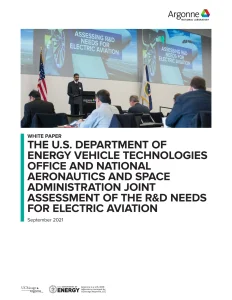- Directory
- Advanced Air Mobility White Papers
- Advanced Air Mobility (AAM)
- JOINT ASSESSMENT OF THE R&D NEEDS FOR ELECTRIC AVIATION
JOINT ASSESSMENT OF THE R&D NEEDS FOR ELECTRIC AVIATION
HotWhite Paper Details
This white paper reviews the R&D needs for electric aviation energy storage, emphasizing battery technology advancement. It focuses on meeting unique aviation requirements through collaboration between DOE and NASA, highlighting near- and long-term goals for aircraft battery design and energy densities to enable commercial electric aircraft.<!-- notionvc: 44c2b612-6a0d-4de7-8577-3d81479567b6 -->
This white paper presents findings from a December 2019 joint workshop hosted by the U.S. Department of Energy Vehicle Technologies Office (VTO) and NASA Glenn Research Center at Argonne National Laboratory. The report provides a comprehensive assessment of research and development (R&D) needs for electric aviation, with a specific focus on energy storage technologies critical for electric aircraft propulsion. The paper highlights the growing shift towards electric aviation driven by factors such as reduced fuel and maintenance costs, decreased noise and emissions, and new design possibilities enabled by electric motors and distributed propulsion.
The assessment identifies four key aircraft design concepts—eVTOL, 9- to 20-passenger commuter, 50-passenger regional, and 150-passenger 737-class aircraft—each with distinct battery energy density requirements ranging from about 300 Wh/kg to greater than 700 Wh/kg.
Current lithium-ion (Li-ion) battery technology supports near-term eVTOL and small commuter aircraft but remains insufficient for larger regional and commercial aircraft, necessitating novel chemistries and battery architectures.
Workshop participants explored a variety of battery innovations, including next-generation Li-ion chemistries (silicon anodes, high-energy cathodes) and beyond-Li-ion options (Li-sulfur, Li-air, sodium-ion), as well as solid-state batteries and fuel cells. Unique aviation operational demands, such as sustained high power during takeoff/landing and varying cycle/capacity life, differentiate aircraft batteries from automotive applications, requiring tailored R&D pathways.
The report recommends a multi-pronged research agenda focusing on evaluating high discharge rates in Li-ion cells, advancing solid-state battery manufacturing, exploring ultra-high energy density systems, and developing mission-specific testing and packaging standards. The collaboration intends to leverage existing EV battery advancements while addressing aviation’s unique challenges to propel the industry toward commercial viability within 5-10 years.
<!-- notionvc: f31330d7-e65f-4b6d-a394-be8504d0fe45 -->
